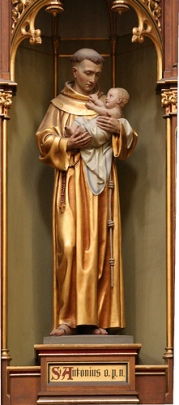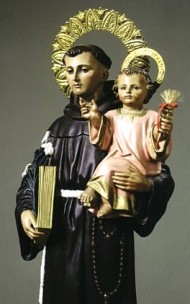Cult and iconography of St Anthony de Padua.

On the day June 13th, the feast of St. Anthony of Padua, principal patron of this blog, along with Francis of Assisi and Catherine de Alexandria, I would like to congratulate you all: the regulars, the ones who comment, the ones that don’t stand me, the ones who ask, the ones who collaborate... to everyone. Many blessings from the saint. I want to make some brief notes on the cult of St. Anthony and his iconography, both very varyed. Anthony is probably the most represented saint in art, along with St. Francis, and even more in statues for worship. In churches is frequent to see their images, making it perfectly recognizable. Local traditions, legends, proverbs and superstitions, have Anthony as an object. All continents know him, and his image has been extended long beyond the limits de the Franciscan Order.
Saint with a reputation for miraculous finder of objects, boyfriend seeker, relied for almost everything, patron de the poor and beggars, a man of letters and excellent preacher ... is so Anthony, loved and revered around the world:
Worship:
St. Anthony received cult virtually since his death, and June 13 was from the beginning on the day of the liturgical memory (though he died 12) since his canonization in 1232, the year after his death. Also, Padua held on 17 June and February, the translation of the relics. Pope Sixtus V, a conventual franciscan, extended the feast to the whole Church. And Pius XII in 1946, he was named Doctor of the Church, although from the fifteenth century, at least, was recognized and represented as such.
Antoniane Devotions and prayers:
The Responsory: This is the first time, known until today, the Responsorial is attributed to St. Bonaventure, but in fact he wrote Friar Julian de Speyer, in 1234.
The thirteen Tuesdays: Its origin is varied and there is no agreement, some say it commemorates his funeral, which occurred on Tuesday, others who started as ninth by a devotee of Bologna, which lasted four Tuesday more to not getting their order. Deten take place publicly in Franciscan churches. Has shortened version de "Thirteen minutes to St Anthony."
The rosary: is a type de crown, repeating Our Father, Hail Mary and Glory, for thirteen consecutive times. Stems from the nineteenth century.
The Cross of St Anthony: A cross Greek, especially dedicated to St Anthony, with the image of the saint in verse and his blessing on the back. It’s a blessing you used Antonio to others: "Behold the Cross of the Lord all my enemies flee. Has won the Lion of Judah, the Root of David. Hallelujah, Hallelujah!".
Prayer to the tongue: In 1263 St Anthony’s body was exhumed and found intact language, weird thing, because its composition is the first to be incorrupted. Was placed in a reliquary, which is currently displayed in Padua. This prayer is the only prayer that is known to be directed especially to a body part de the saint. So, he goes to Anthony, but with special reference to the language, and this because he always praised God and led others to praise him. He spoke of men and interceded for them before God.
The scapular of St Anthony: Like all scapulars are brown two-piece, joined by two white cords. You can always be replaced by the St Anthony medal.
The bread of the poor: the work is devoted to more social outreach. Born in France in the nineteenth century and consisted de two piggy banks were placed to the left and right of the image of the saint. In a paper to be put requests to the saint, which were extracted and by which members prayed. In the other, put a donation in cash and thanks for the request heard by the saint, and the proceeds are devoted entirely to the poor. No longer practiced today, although many charities continue to have the saint as protector. Also on the day of your party is customary in Portugal, Spain and South America, mainly to passing out candy and bread blessed.
Iconography:
In general, St. Anthony is portrayed as a beardless youth, and stylized. Although exceptions exist, such as pictures or paintings sponsored by the Capuchins, where the saint does have a beard, but never the classic bearded Capuchin three feet. The oldest paintings are more realistic and do not affect the beauty, as it makes the Baroque, it feminoid figure, movements and angelic beauty.
Habit: Well, we can find in various forms. The most common is the brown robe, cord three knots on the right and left rosary. However, baroque images look five knots, for the five wounds, and South America is common to see blue, from the eighteenth century. Sometimes, it is not the most usual, has short coat, the Franciscan style. Another aspect to note is that, depending on the church, we can see gray cape and wide, if the site is a franciscan conventual monastery, or long hooded cloak and no, if it is a capuchin monastery.
The Child Jesus: It is your most distinctive iconographic element. It is said that a host of the saint, saw the baby Jesus visited Antonio in his prayer. Anyway, the truth is that the antoniane images tend to give the saint Child, mainly in three versions:
1: Tucked away in his arms and looking ecstatic, these images are deten of great expression and tenderness, are those of the Baroque.
2: The Child between glares down from heaven and Anthony opens its arms to him in this way the paintings and stamps are frequent pious.
3: The child sits on a book, although iconographically be a solution to include the book in images, but the iconography of the Child on the book is more deep: the wisdom, preaching and teaching the St. Anthony is supported by Christ.
The book: As with the other saints, the book is a symbol de wisdom and teaching. May be the Gospels, if an apostle or a book of rules, if a Founder. In the case of Anthony, holds his teaching, preaching and teaching, which earned him a Doctor of the Church. Unfortunately, your side has hidden too miraculous knowledge de his work, expressed in his "sermons".
The lily: Is a symbol the purity excellence, dedication and love virginal. Always accompanies him in the form de a small branch, not as a blossoming rod, as in the case the St. Joseph.
The heart on fire: A flame is a symbol of faith and love that fills the heart of the saint and spreads to others. Only what we see in old and rare performances, as the iconographic repetition, missed this attribute.
The crucifix: The cross has many meanings, and is generally belonging to Christ and radical following. It is a sign de victory over sin and death. It is very common in Anthony, leading to the Child Jesus, but you can see in some Baroque paintings as part of its iconography "environmental" (hair shirts, skulls, books, pen writer). In some cases, few, wearing a crucifix flowered lilies, recalling her victory over the carnal temptations of youth.
Breads: In many sculptures and paintings, St. Anthony appears to give bread to a poor and with a bag full of bread. Proverbial was charity de the saint, coming to empty the pantry of the communities where he lived, on the other hand, something that Francis always wanted, nothing was saved and shared with the poor.
The Virgin Mary: An element’s own paintings are the Marian apparitions to the saint to give the Child. And this in various ways, Anthony playing with the Child, which remains in the lap of Mary, Anthony received the Child of Mary’s hands, and the most common: Mary from heaven, sees her child in the arms of Anthony. Another common representation is the Marian apparition at the time de the death of Anthony.
Custody or ciborium: we see in the environment of the miracle occurred when a donkey fell down before the Sacrament, worshiping Him, before coming to eat. With this miracle, Anthony was able to convert several heretics.
By Ramon Rabre (text) and Marco Antonio Martinez Ruvalcaba (translation)
